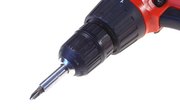
Two Different Systems
Mechanics use mathematics all the time in their daily routine of repairing and modifying internal-combustion automobiles. Their use of numbers takes on many forms; from determining the size of the wrench they need to loosen a bolt to calculating torque, today’s mechanics need to have a good head for numbers. They also have to deal with two different numeric systems: metric and American (sometimes called British). The metric system is based on a 10-digit numerical system, but the British system, which we also use here in the United States, is based on the English foot (which comes in units of 12, yet still uses the same10-digit number system). As a result, most modern mechanics are constantly switching from one system to another--an activity that is not as difficult as it sounds.
The Nuts and Bolts of Mechanic's Math
The first and probably most obvious use of mechanic’s math is in the area of fractions. Every bolt or nut in an engine or car body has a certain designated size. The head of a bolt is usually six-sided, but on occasion, you might find one that is square, with only four sides. (The battery terminal has square bolts.) If you are using the English system, the smallest unit of measurement is the inch. Anything less than 1 inch is referred to in fractions. In auto mechanics, this is a common occurrence, as most bolts that go into the making of a modern engine average around 1/2 inch to 5/8 inch. It is even possible to have bolts that are 3/4, 1/2 or 9/16 inch in size. As you can see, understanding fractions is fundamental in comprehending the English system. On the other hand, the metric system is designed so that fractions are almost unheard of. Instead of using fractions, one simply drops down to the next level. For instance, there are approximately 2-1/2 centimeters in 1 inch. If you have a bolt with a head that is less than 1cm, which is a common occurrence, instead of using a fraction to designate the size, you merely go to the next level, which is measured in millimeters. There are 100 millimeters in one centimeter, so a 1/2-inch bolt ends up being equal to about 13mm. It really is not that difficult to comprehend, especially once you get some hands-on experience. Just remember that a different set of tools is needed to work on each type of car. A good mechanic needs to have both.
Torque and Engine Displacement
Numbers also come into play in many other ways, such as calculating torque, engine size and displacement, horsepower and firing sequence. Torque is expressed in foot-pounds, and is a measurement of the force needed to tighten a bolt.
"Horsepower" is a common term, yet few people realize that is also a mathematical formula. You calculate horsepower by multiplying the diameter of a cylinder (in inches) by the number of cylinders and then dividing that figure by 2.5.
Engine size is the volume of the engine. It is the combination of the volume of all 4, 6 or 8 cylinders (whichever may be the case). This is also called engine displacement. The firing sequence refers to the order in which each cylinder is ignited (or fired); it is determined by the manufacturer. The sequence is not random, but occurs in a highly researched order, designed to give maximum power and efficiency to the engine.
It is easy to see how important numbers are in the manufacture and maintenance of automobiles, and it is also important that mechanics and machinists have a good understanding of these two numerical systems.
About the Author
Henri Bauholz is a professional writer covering a variety of topics, including hiking, camping, foreign travel and nature. He has written travel articles for several online publications and his travels have taken him all over the world, from Mexico to Latin America and across the Atlantic to Europe.
